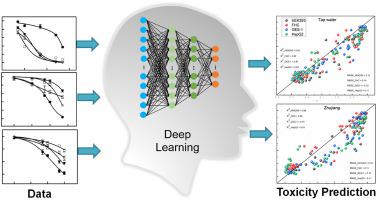Chemosphere ( IF 8.8 ) Pub Date : 2021-09-21 , DOI: 10.1016/j.chemosphere.2021.132324 Jiahui Wang 1 , Gaoxing Su 2 , Xiliang Yan 3 , Wei Zhang 3 , Jianbo Jia 3 , Bing Yan 3

|
Biological assays are useful in water quality evaluation by providing the overall toxicity of chemical mixtures in environmental waters. However, it is impossible to elucidate the source of toxicity and some lethal combination of pollutants simply using biological assays. As facile and cost-effective methods, computation model-based toxicity assessments are complementary technologies. Herein, we predicted the human health risk of binary pollutant mixtures (i.e., binary combinations of As(III), Cd(II), Cr(VI), Pb(II) and F(I)) in water using in vitro biological assays and deep learning methods. By employing a human cell panel containing human stomach, colon, liver, and kidney cell lines, we assessed the human health risk mimicking cellular responses after oral exposures of environmental water containing pollutants. Based on the experimental cytotoxicity data in pure water, multi-task deep learning was applied to predict cellular response of binary pollutant mixtures in environmental water. Using additive descriptors and single pollutant toxicity data in pure water, the established deep learning model could predict the toxicity of most binary mixtures in environmental water, with coefficient of determination (R2) > 0.65 and root mean squared error (RMSE) < 0.22. Further combining the experimental data on synergistic and antagonistic effects of pollutant mixtures, deep learning helped improve the predictive ability of the model (R2 > 0.74 and RMSE <0.17). Moreover, predictive models allowed us identify a number of toxicity source-related physiochemical properties. This study illustrates the combination of experimental findings and deep learning methods in the water quality evaluation.
中文翻译:

通过实验和深度学习方法预测环境水中二元污染物对人体细胞面板的细胞毒性
通过提供环境水体中化学混合物的总体毒性,生物分析可用于水质评估。然而,仅仅使用生物测定法不可能阐明毒性的来源和污染物的一些致死组合。作为简便且具有成本效益的方法,基于计算模型的毒性评估是互补技术。在此,我们使用体外生物测定法预测了水中二元污染物混合物(即 As(III)、Cd(II)、Cr(VI)、Pb(II) 和 F(I) 的二元组合)对人类健康的风险和深度学习方法。通过使用包含人类胃、结肠、肝脏和肾脏细胞系的人类细胞面板,我们评估了在口服暴露于含有污染物的环境水后模拟细胞反应的人类健康风险。基于纯水中的实验细胞毒性数据,应用多任务深度学习来预测环境水中二元污染物混合物的细胞响应。利用可加性描述符和纯水中的单一污染物毒性数据,建立的深度学习模型可以预测环境水中大多数二元混合物的毒性,确定系数(R2 ) > 0.65 且均方根误差 (RMSE) < 0.22。进一步结合污染物混合物协同和拮抗作用的实验数据,深度学习有助于提高模型的预测能力(R 2 > 0.74 和 RMSE <0.17)。此外,预测模型使我们能够识别许多与毒性来源相关的理化特性。本研究说明了实验结果和深度学习方法在水质评估中的结合。


























 京公网安备 11010802027423号
京公网安备 11010802027423号